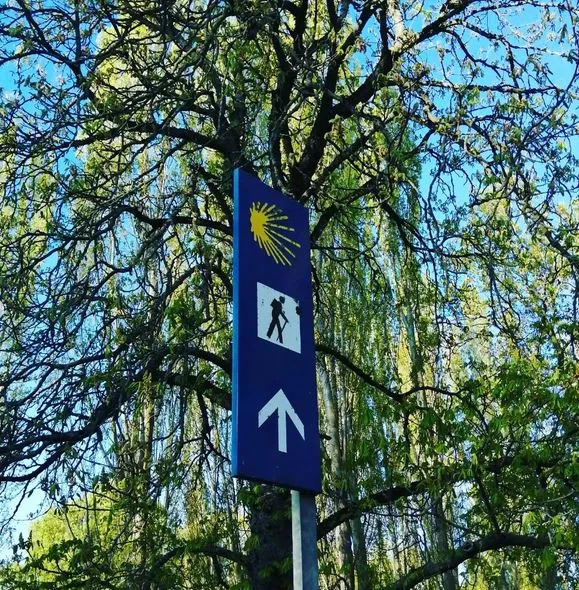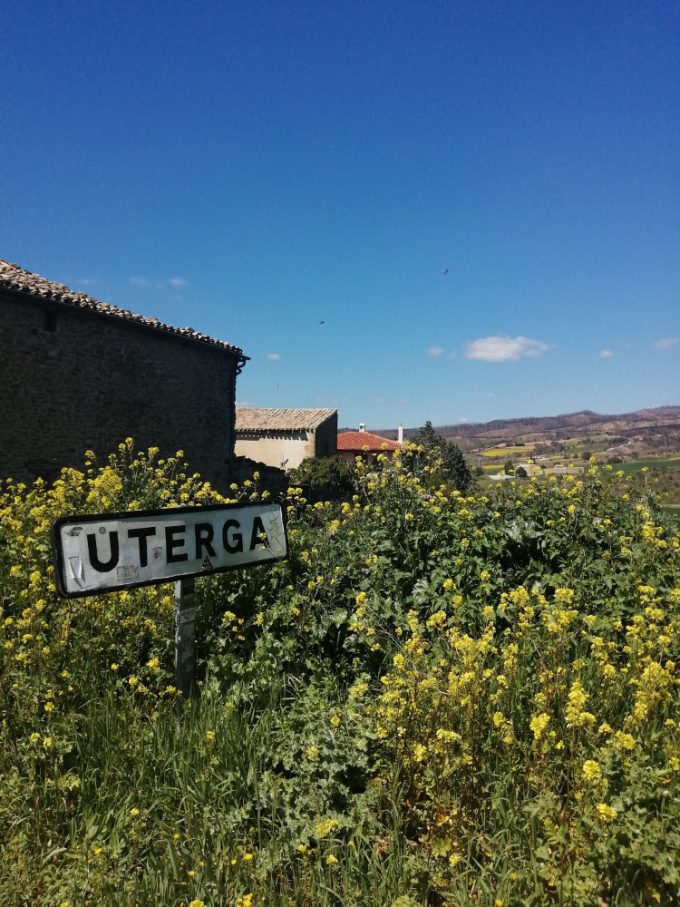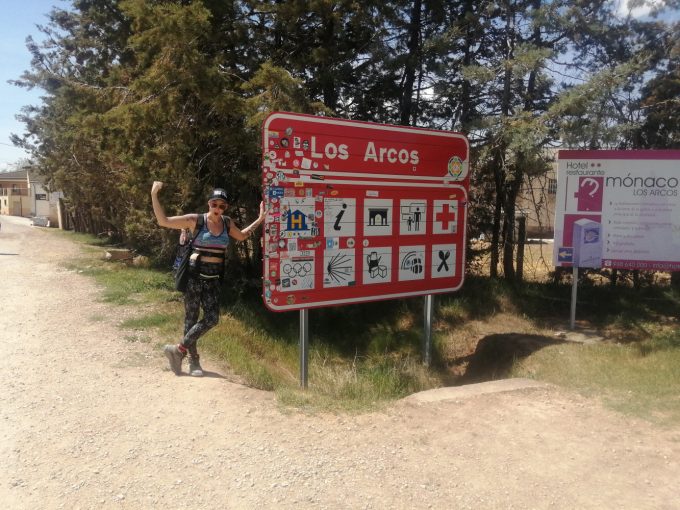
How I decided to walk 100 miles across Spain
16 May, 2023
The long journey to the Camino Frances, and the first couple of days along the way…
Boxing Day, 2019. I’m lounging on the carpeted floor of my brother-in-law’s cold Bury flat, leaning against my partner’s legs as they doze on the sofa, fucked on painkillers. Five weeks ago, they underwent the last of a series of surgeries to hopefully sort a massively mobility-impacting injury they’ve been struggling with for the entire year. My father-in-law is telling me how many people die climbing Mount Everest: less than half who attempt to climb the highest mountain in the world ever make it to the summit, and it’s much too dangerous to retrieve the bodies of the ones who die along the way. There are hundreds of them, their frozen corpses left in situ to serve as landmarks for their successors.
It’s just me and him, the other family members faffing and muttering about the temperamental oven in the open-plan kitchen. And somewhere among this morbidly philosophical description is a reflection on the psyche of extreme adventurers: the perverse pull of wild and treacherous terrain, our desire as humans to push ourselves up to and beyond our limits as we explore places we’ve never been.
For some reason, this reminds me of a conversation with a friend a decade earlier, detailing her anecdotes when she came back from a holiday walking across Spain. I remember none of the details, only how transformative she said it had been. When the Boxing Day buffet is ready, I sneak out my phone. ‘Walking route Spain’, I type in, and bookmark the search results.
That night, I’m down the rabbit hole, piecing together details from my research and old memories of that chat with my mate all that time ago to identify that the route she did was the Camino Frances, a pilgrimage route across France and Spain whose history goes back centuries. The thought of it burrows down somewhere deep inside me, a little ember I can’t explain. I keep thinking about it. Keep reading about it. And before even really realising what I’m doing, I’m jotting down notes in a Google doc, a makeshift list of bullet points that slowly becomes an itinerary.
Maybe this is something I can do next year, I think, the possibility bizarre but tantalising after a year of not being able to leave the house without considering everything my partner might possibly need while I’m out and making sure all the necessities were in easy reach. 2019 turns into 2020. A global pandemic hits, and travel becomes a distant dream. But the idea remains. By the time lockdown restrictions lift enough that international travel is a possibility again, everything – and everyone – is different. In 2022, I’m grateful to be able to go abroad several times, but the Camino is still calling.
The classic French Camino route is almost five hundred miles long, and takes most people somewhere between four and six weeks to walk. I can’t afford that long away from work, or from my family caregiving responsibilities. But I can do a week, maybe a bit more. I put it in the calendar, book flights to and from Bilbao. By now, I’ve gone on about the idea so much that my partner wants to come too. I plan our path walking from Pamplona to Burgos, and soon the day has come: we’re in the airport with the tiniest backpacks we could wangle, only one change of clothes each, a tiny notebook, medications, a few toiletries. We are both incredibly anxious travellers, even with our sunflower lanyards, earplugs and last week’s Succession downloaded for the journey. But we make it to Bilbao, then to our car-share to Pamplona.
I explain what we’re doing in stumbling Spanish and the other passenger with us gives a mile-wide grin, launches into a passionate monologue about people he’s known who’ve done the same thing. “Everyone who does the Camino comes back so happy,” he says. We whizz down the motorway, past dazzlingly beautiful scenery: forests, mountains, fields of vivid yellow flowers. Later, we’re in our hotel for the night, the city strangely quiet as we wash our socks and knickers in the sink, ready for our first day’s walking the next day. Before bed, I stand on the cold balcony, thinking about how old European architecture always reminds me of Only Lovers Left Alive. And I’m struck by how surreal and beautiful it is that we can take our strangest and most inexplicable fascinations and follow them to unexpected places.
➰⭐➰
The city is silent when I wake up. In the dark, I slip out of bed and into the shower The water is hot and so high pressure it’s almost bruising. I’m grateful for it. Grateful for my body and all the things it might experience on this trip. Grateful for the simple pleasure of hot water followed by a fluffy towel that I wrap myself in and stand shivering on the balcony, watching the passing trickle of commuters.
The Camino is signposted by yellow arrows and scallop shells, some official and some not. While the trail itself has existed for centuries, the route as it exists today owes a debt of gratitude to Don Elías, a priest who’d studied the pilgrimage in-depth and – in the early eighties – took it upon himself to start marking the path towards Santiago, driving a Citroen van full of tins of yellow paint across Northern Spain and daubing arrows at any unmarked crossroad or other potentially misleading point on the path.
The path is so well-marked now that between Pamplona and Burgos I never once looked at a map. The only time we consulted it was that first cold but bright morning in Pamplona, rambling down city streets and past the old city walls. The first shell we found was on a traffic marker; on the next block there were scallop tiles set into the floor, leading us over a roundabout and then onto a stretch out of town, where the city gave way to fields, blue skies and beauty in an absurdly short amount of time.
We fell in with other walkers, or almost. Seeing people with scallop shells knotted to their backpacks reassured us we were on the right path. And at a certain point, the path turns away from the road and across fields towards the hills, a steep upward silhouette with spinning wind turbines too massive to comprehend even when we’re still miles away.

I’d read some horror stories about the path up Alto del Perdon – The Mount of Forgiveness – and it’s steep, but not as bad as I feared. At its summit is a metal sculpture and ridiculous panoramic views, along with several makeshift shrines; a signposted has been wrapped with prayer flags, memorial stones piled around its base along with smaller tribute pebbles marked with names and dates, brought to this place in the pockets of travellers from all over the world.

Going down is harder than going up, and would’ve been even more treacherous if it was wet, though we still witnessed a few tears and tumbles. By the time we make it to Uterga, everyone is ready for a rest, but that means the one albergue with the garden terrace and cafe has a queue reaching out the door. I sit in the shade for a minute, laughing when an Irish lad at the next table comes back from the bar with a tray of beers and what had been sold to him as ‘summer drink’. With cute intentions of keeping himself and his pals well-hydrated, he’d ordered them one each to go with the beer. At the table they discover ‘summer drink’ is red wine, ice and lemonade.
I can’t be arsed queueing so we ransack the overpriced vending machine in the garden for actual soft drinks, then continue on our way, the only ones in sight as we stomp through woods, fields and several ghost-town villages to make it to Puenta la Reina far earlier than we’d planned. The next morning, we head out over the bridge the town is named for and along the old Roman road, following the yellow arrows through wheat fields, olive groves and vineyards, under a bypass then a canal propped up on huge cement struts, until we find a deserted rest area: shady picnic tables and another tree wrapped in prayer flags with trinkets, messages and tiny bells hung from its branches, but not a single soul in sight.
We are on our way to Estella, a medieval town with multiple palaces, convents and churches, and a place that’s already become almost mythic to me because the day before I’d overheard someone explaining she was on her second attempt at the Camino; on her first she’d had to give up by Estella because she got seven gruesome blisters in six days and was in too much pain to continue.

I’m hot and moody by the time we reach the last stretch from Villatuerta, grateful for the shade of the forest on the high path above the river and the dizzy chill of the supermarket once we make it into town. Our B&B for the night is up a hill but the owner has kindly offered to collect us; after only two days of walking, being in a car again feels ludicrously fast and disorientating. But the place is perfect: a quiet, hidden-away sanctuary with a lush garden where we eat our supermarket picnic. The owner tells me we can wash our clothes in the garage and hang them in the sun; he offers to bring them in when it gets dark. I fumble for my Spanish to ask what time sunset will be: the closest I can get is “a que hora se va a dormir el sol?” What time does the sun go to sleep? He is all solemn twinkles when he understands and answers: nine. The sun goes to bed about nine.
Originally shared via my newsletter in May 2023 on my return from the Camino Frances